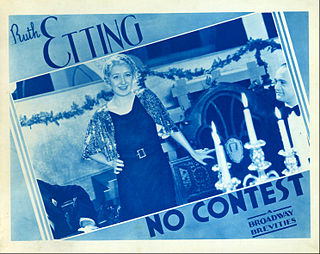Related Research Articles
Bubbles is a 1930 American Vitaphone Varieties short film released by Warner Bros. in Technicolor. It was filmed in December 1929 at the First National Pictures studio with Western Electric apparatus, an early sound-on-film system, Rel. No. 3898. Bubbles is one of the earliest surviving recordings of Judy Garland on film, at 8 years old.
André de la Varre was a leading travelogue filmmaker from a prominent family who started as a 17-year-old visiting Europe with a recently acquired movie camera at the end of World War I. Born Franklin LaVarre, he was the brother of noted Westerns actor John Merton, the journalist/explorer William LaVarre, and the international businessman Claude LaVarre.
Scope Gem was a marketing series title that Warner Brothers used for documentary film shorts produced in Warnercolor and the wide-screen CinemaScope format. Most of these were travelogues.
World Wide Adventures is a generalized name applied to Warner Bros. live-action short films of the 1960s. Usually, the trade magazines like BoxOffice only listed the one-reelers under this heading, with the longer films simply dubbed “specials.” For the most part, this was a handy marketing logo for a wide range of shorts of the documentary genre.

Edward M. Newman (1870–1953) was a film producer of many documentary film shorts released by Warner Brothers and edited at Vitaphone studios in Brooklyn, New York in the 1930s. These were mostly of the travelogue genre. He was born in Cleveland, Ohio on March 16, 1870. His parents were Hungarian immigrants. He died in Los Angeles, California on April 16, 1953.
The “Vitaphone Color Parade” was a series of documentary short films produced by Warner Bros.
The name “Technicolor Adventure” was used by Warner Bros. to define its one-reel film shorts that were not part of the Sports Parade, also shot in Technicolor in the 1940s. Most were travelogues or human interest documentary films. Gordon Hollingshead produced most of them, with music scores provided by Howard Jackson.
The Sports Parade was a short film series of Warner Bros. that was regularly shown before the main studio feature, along with another Warner-Vitaphone short, Joe McDoakes comedy and/or Looney Tunes and Merrie Melodies cartoons. The average running time of each film was between nine and eleven minutes.
The Sport Slants and its follow-up “Sports Thrills” were a series of documentary film shorts produced by Warner Brothers and hosted by the top sports caster of the 1930s, Ted Husing.
Adventures in Africa is a series of Warner Bros. documentary film shorts inspired by the success of Martin and Osa Johnson and concurrent features such as Africa Speaks! and Trader Horn.
Vitaphone Varieties is a series title used for all of Warner Bros.', earliest short film "talkies" of the 1920s, initially made using the Vitaphone sound on disc process before a switch to the sound-on-film format early in the 1930s. These were the first major film studio-backed sound films, initially showcased with the 1926 synchronized scored features Don Juan and The Better 'Ole. Although independent producers like Lee de Forest's Phonofilm were successfully making sound film shorts as early as 1922, they were very limited in their distribution and their audio was generally not as loud and clear in theaters as Vitaphone's. The success of the early Vitaphone shorts, initially filmed only in New York, helped launch the sound revolution in Hollywood.
Technicolor Special was a common term used for Hollywood studio produced color short films of the 1930s and 1940s that did not belong to a specified series.
The Big V Comedies were two-reel comedy film shorts produced by Warner Bros. and Vitaphone between 1931 and 1938, contemporary of the more famous Hal Roach, Mack Sennett and Columbia Pictures comedies.

Broadway Brevities are two-reel musical and dramatic film shorts produced by Warner Bros. between 1931 and 1943. The series continued as Warner Specials in later years.
The Melody Masters were a series of first-rate big band musical film shorts produced by Warner Brothers, under the supervision of Samuel Sax at their Vitaphone studio in New York between 1931 and 1939, and in Burbank, California with producer Gordon Hollingshead in charge between 1940 and 1946.
Big Time Vaudeville was a series of black-and-white 9- to 10-minute short films resembling the Vitaphone Varieties and also produced by Warner Brothers and Vitaphone. These consisted of four to six vaudeville acts and are historically interesting with many performers rarely seen on film.
The Naggers was a series of 18 film short films produced by Warner Brothers at the Vitaphone studio in Brooklyn, New York. These featured Jack Norworth and Dorothy Adelphi as an arguing husband and wife in a variety of domestic settings. This basic premise predated the popular radio series The Bickersons and many future TV marital comedies.
Vitaphone Pictorial Revue was a series of 9-11 minute newsreel oriented (documentary) film shorts produced by Vitaphone and Warner Brothers.
The Swell Head is a 1928 American romantic musical short starring Eddie Foy Jr. and Bessie Love, directed by Foy's brother Bryan. Variety mused that "this may be the first backstage sound short."
References
- Liebman, Roy (2003). Vitaphone Films – A Catalogue of the Features and Shorts. McFarland & Company. ISBN 9780786412792.
- Motion Pictures 1950-1959 Catalog of Copyright Entries 1960 Library of Congress
- Motion Pictures 1960-1969 Catalog of Copyright Entries 1971 Library of Congress
- BoxOffice back issue scans (release date information in multiple issue “Shorts Charts”)